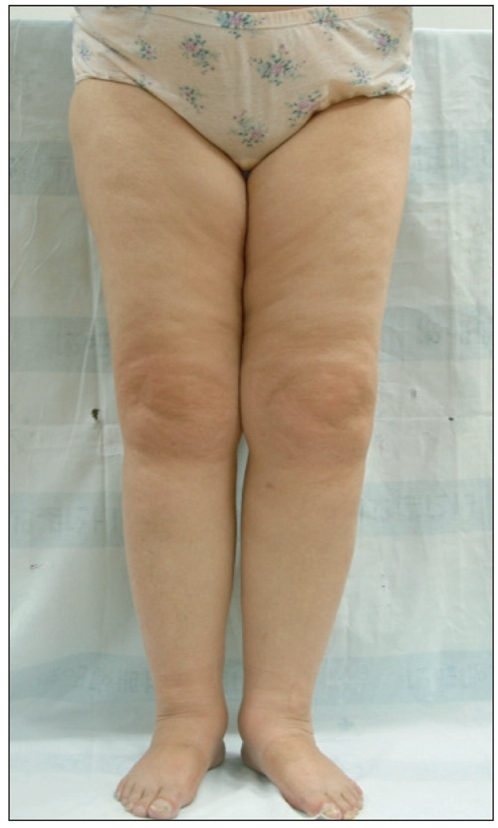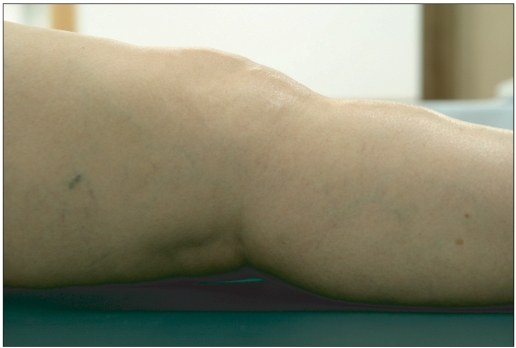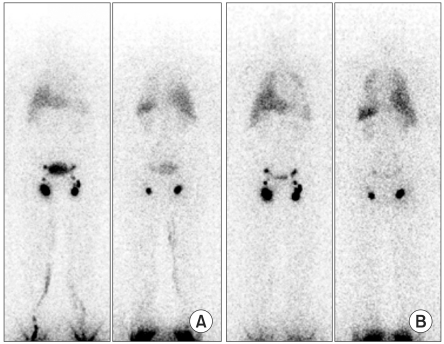Ann Rehabil Med.
2011 Dec;35(6):922-927. 10.5535/arm.2011.35.6.922.
Lipedema, a Rare Disease
- Affiliations
-
- 1Department of Physical Medicine and Rehabilitation, Kosin University College of Medicine, Busan 602-702, Korea. oggum@hanmail.net
- KMID: 2266819
- DOI: http://doi.org/10.5535/arm.2011.35.6.922
Abstract
- Lipedema is a chronic disease of lipid metabolism that results in the symmetrical impairment of fatty tissue distribution and storage combined with the hyperplasia of individual fat cells. Lipedema occurs almost exclusively in women and is usually associated with a family history and characteristic features. It can be diagnosed based on clinical history and physical examination. Lipedema is usually symmetrical, but spares the feet, is often painful to palpation, and is negative for Stemmer's sign. Additionally, lipedema patients can present with microangiopathies and lipomas. The well-known therapies for lipedema include complex decongestive therapy, pneumatic compression, and diet modifications. However, whether these treatments help reduce swelling is debatable. We encountered a case of lipedema that was initially misdiagnosed as lymphedema. The patient's clinical features and history were different from those typical of lymphedema, prompting a diagnosis of lipedema and she was treated with a complex decongestive therapy program.
Keyword
MeSH Terms
Figure
Reference
-
1. Weisseleder H, Schuchhardt C. Lymphedema diagnosis and therapy. 2008. 4th ed. Germany: Viavital;p. 294–323.2. Child AH, Gordon KD, Sharpe P, Brice G, Ostergaard P, Jeffery S, Mortimer PS. Lipedema: an inherited condition. Am J Med Genet A. 2010; 152A:970–976. PMID: 20358611.
Article3. Juther JE. Lymphedema management: the comprehensive guide for practitioners. 2005. 1st ed. New York: Thieme;p. 87–89.4. Földi E, Földi M, Ströβenreuther R, Kubik S. Textbook of lymphology for physicians and lymphedema therapists. 2006. 2nd ed. Munchen: URBAN & FISCHER;p. 396–403.5. Pascucci A, Lynch PJ. Lipedema with multiple lipomas. Dermatol Online J. 2010; 16:4–9. PMID: 20875325.
Article6. Szolnoky G, Nagy N, Kovacs RK, Dosa-Racz E, Szabo A, Barsony K, Balogh M, Kemeny L. Complex decongestive physiotherapy decreases capillary fragility in lipedema. Lymphology. 2008; 41:161–166. PMID: 19306662.7. Rudkin GH, Miller TA. Lipedema: a clinical entity distinct from lymphedema. Plast Reconstr Surg. 1994; 94:841–847. PMID: 7972431.8. Szolnoky G, Borsos B, Barsony K, Balogh M, Kemeny L. Complete docongestive physiotherapy with and without pneumatic compression for threatment of lipedema: a pilot study. Lymphology. 2008; 41:40–44. PMID: 18581957.9. Macdonald JM, Sims N, Mayrovitz HN. Lymphedema, lipedema, and the open wound: the role of compression therapy. Surg Clin North Am. 2003; 83:639–658. PMID: 12822730.




